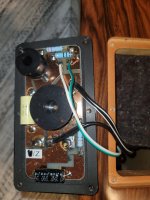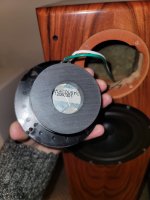Is there any way to tell what the values of these air core inductors are? This is the crossover for a Vienna Acoustics Maestro center speaker.
I am planning on swapping out the tweeter, (which sounds harsh), and replacing with a ScanSpeak Classic to match my main speakers.
It is odd...the original versions of the Maestro came with that ScanSpeak tweeter. This version seems to have a much cheaper tweeter (I picked it up secondhand off Ebay a few years ago). This tweeter has the same impedance as the ScanSpeaktho, so I think I can start simple. I'd like to try a straight swap first, listen, and then adjust the crossover values once I understand what needs to be adjusted.
I plan to use my studio mic to capture the freq response.
I have a Fluke189 multimeter. Any way to run a test to find the mH values without desoldering?
I am planning on swapping out the tweeter, (which sounds harsh), and replacing with a ScanSpeak Classic to match my main speakers.
It is odd...the original versions of the Maestro came with that ScanSpeak tweeter. This version seems to have a much cheaper tweeter (I picked it up secondhand off Ebay a few years ago). This tweeter has the same impedance as the ScanSpeaktho, so I think I can start simple. I'd like to try a straight swap first, listen, and then adjust the crossover values once I understand what needs to be adjusted.
I plan to use my studio mic to capture the freq response.
I have a Fluke189 multimeter. Any way to run a test to find the mH values without desoldering?
Attachments
To measure the frequency response you need an omnidirectional microphone, not a typical cardioid studio microphone.
Reasonable enough. I can pick one up. My next project will be a set of custom small bookshelves, so I should get one anyway.omnidirectional microphone
The coil should be removed from the circuit for measuring. Looking at the 189 owner's manual, I don't believe it will measure inductance.I have a Fluke189 multimeter. Any way to run a test to find the mH values without desoldering?
Last edited:
I think this is my crossover schematic.

What does the 10R resistor in parallel with the tweeter do? Is that just to pad it out to the same R and SPL as the the pair of woofers?
What does the 10R resistor in parallel with the tweeter do? Is that just to pad it out to the same R and SPL as the the pair of woofers?
10R is part of fixed L-pad. It reduces signal to the tweeters in order to match lower sensitivity of midbass.
Thanks. That is what I thought.10R is part of fixed L-pad. It reduces signal to the tweeters in order to match lower sensitivity of midbass
Since it is a 2nd-order crossover, I tried reversing the polarity on the tweeter. That actually helped with the brightness (less "shouty" now), and I will leave it this way until I can model a new crossover for the new tweeter.
There's some ridiculously cheap "transistor tester" gadgets that claim to work as LCR meters as well. Or set up a computer sound card to do impedance measurements using "Speaker Workshop" or other software.
Behringer sells a measurement microphone, ECM8000. I suspect the calibration mics bundled with AV receivers are good enough, if you have one lying around. They show up at thrift stores from time to time.
Behringer sells a measurement microphone, ECM8000. I suspect the calibration mics bundled with AV receivers are good enough, if you have one lying around. They show up at thrift stores from time to time.
You have a pc ?
Get a dayton dats.
All the other cheap testers will lead you down a dark alley as you have no idea what signal they generate to get their results.
And yes, you will need to unsolder one leg of the part under test.
Get a dayton dats.
All the other cheap testers will lead you down a dark alley as you have no idea what signal they generate to get their results.
And yes, you will need to unsolder one leg of the part under test.
Thanks. I have one of those from my Marantz receiver. I will try it.suspect the calibration mics bundled with AV receivers are good enough
The woofer inductor can be measured without taking it out, as long as the crossover is disconnected. The tweeter is shorted by the L-Pad and you'll have to pull one leg first.
Sounds good, as it may have been made loud by choice.I'd like to try a straight swap first, listen, and then adjust the crossover values once I understand what needs to be adjusted.
Wild guess: a previous owner blew the tweeters and replaced them with those cobbled-together cheapo contraptions. So the crossover might be just fine. Is it similar to the ones in your mains?
That is my theory as well. And this cheap tweeter had leads that were soldered to the crossover wire quick connects. Unlike ALL the other driver connections, which had tabs to attach the quick connects to.Wild guess: a previous owner blew the tweeters and replaced them with those cobbled-together cheapo contraptions. So the crossover might be just fine. Is it similar to the ones in your mains?
I tried to put the tweeter from my main into the center, but the faceplate on the mains tweeter is like 1mm bigger than the center cutout. So it didnt quite fit. I suspect those tweeters are 104.2mm, and the center faceplate is 103.4mm. but it does look like this cheap tweeter was haphazardly attached to the original tweeter faceplate.
Quick question for all of the experts here: the Resistor L-Pad of a 2.2R and 10R. The current cheapo resistor in there is stamped 4 ohms. But VA quotes this as a 6ohm speaker. Do the 4ohm and 2.2R resistor creat the 6 ohm overall impedance for the tweeter range? Or is that 2.2 and 10 just creating an Lpad splitter to reduce current or voltage (cant recall which) to the tweeter, and my impedance is still the driver listed impedance of 4ohms?
The ScanSpeak Classic is 6oms, as is the Seas Prestige. I am now tempted by the Seas Prestige, as that is what was in Proacs, which sounded so nice in the upper freqs when I heard them long ago. And the Seas Prestige has a 103mm faceplate....
I am tempted to just gut this entire center speaker, and rebuilt it with the drivers I want and a crossover to match. And then use the clear coned woofers in a nice little bookshelf build for my upstairs TV room.
(It has been 30 years since my EE classes, and I am rusty on my circuit calc logic. Apologies).
The ScanSpeak Classic is 6oms, as is the Seas Prestige. I am now tempted by the Seas Prestige, as that is what was in Proacs, which sounded so nice in the upper freqs when I heard them long ago. And the Seas Prestige has a 103mm faceplate....
I am tempted to just gut this entire center speaker, and rebuilt it with the drivers I want and a crossover to match. And then use the clear coned woofers in a nice little bookshelf build for my upstairs TV room.
(It has been 30 years since my EE classes, and I am rusty on my circuit calc logic. Apologies).
Getting the overall impedance to 6 or 4 ohms isn't much of a goal in and of itself, the nominal impedance is not that important an issue in that way. Getting the tweeter level good is the main objective, working the two resistor values to function effectively with the tweeter impedance may be another goal, intertwined with keeping the overall impedance usable.Do the 4ohm and 2.2R resistor creat the 6 ohm overall impedance for the tweeter range? Or is that 2.2 and 10 just creating an Lpad splitter to reduce current or voltage (cant recall which) to the tweeter,?
- Home
- Loudspeakers
- Multi-Way
- Values of air core inductors?

